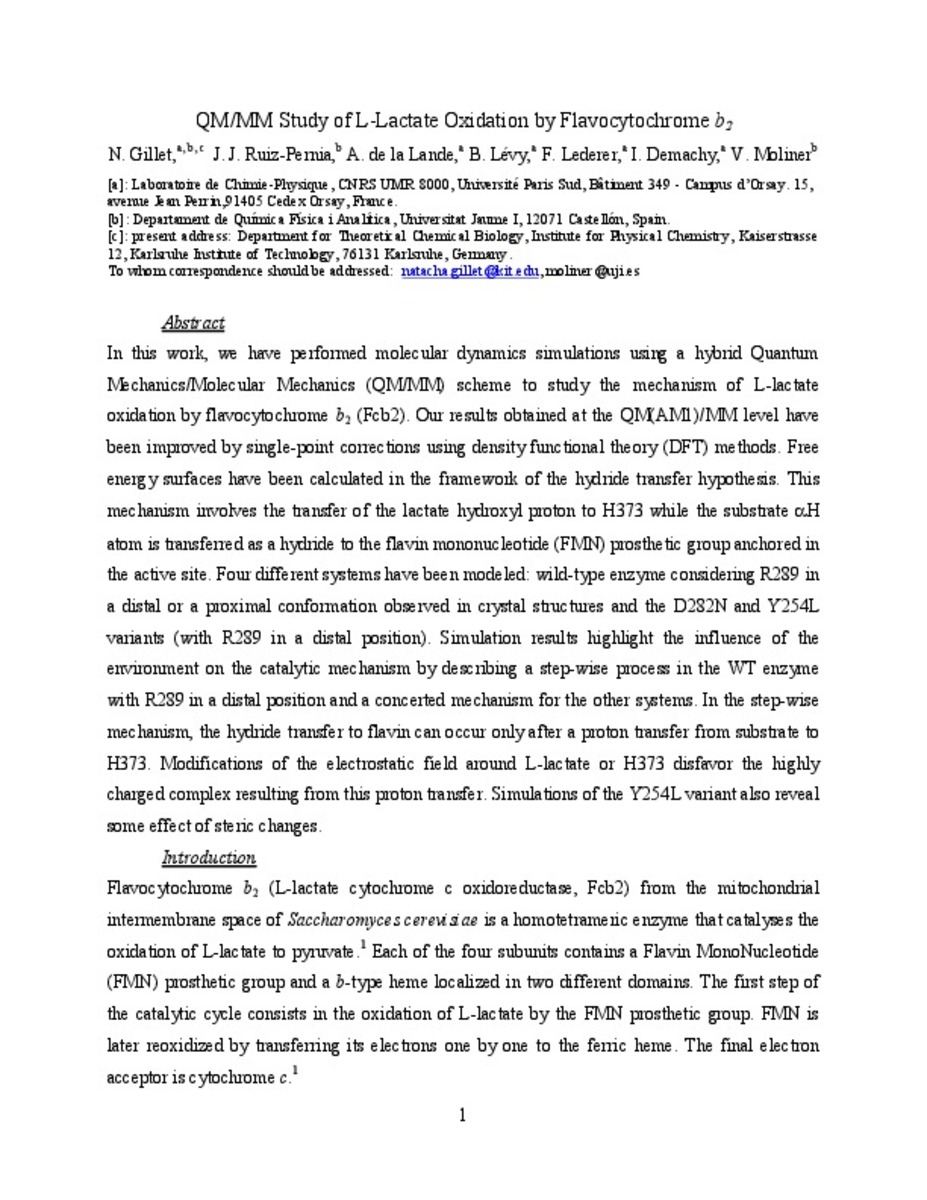Mostrar el registro sencillo del ítem
QM/MM Study of L-Lactate Oxidation by Flavocytochrome b2
| dc.contributor.author | Ruiz-Pernía, José Javier | |
| dc.contributor.author | de la LANDE, Aurélien | |
| dc.contributor.author | Lévy, B. | |
| dc.contributor.author | Lederer, F. | |
| dc.contributor.author | Demachy, I. | |
| dc.contributor.author | Moliner, Vicent | |
| dc.contributor.author | Guillet, Natacha | |
| dc.date.accessioned | 2016-11-16T08:53:30Z | |
| dc.date.available | 2016-11-16T08:53:30Z | |
| dc.date.issued | 2016-05-18 | |
| dc.identifier.citation | GUILLET, N.; RUIZ PERNÍA, J. Javier; DE LA LANDE, Aurélien; LÉVY, B.; LEDERER, F.; DEMACHY, I.; MOLINER IBÁÑEZ, Vicente. QM/MM Study of L-Lactate Oxidation by Flavocytochrome b2. Physical Chemistry Chemical Physics (2016), v. 18, pp. 15609-15618 | ca_CA |
| dc.identifier.uri | http://hdl.handle.net/10234/164463 | |
| dc.description.abstract | In this work, we have performed molecular dynamics simulations using a hybrid Quantum Mechanics/Molecular Mechanics (QM/MM) scheme to study the mechanism of L-lactate oxidation by flavocytochrome b2 (Fcb2). Our results obtained at the QM(AM1)/MM level have been improved by single-point corrections using density functional theory (DFT) methods. Free energy surfaces have been calculated in the framework of the hydride transfer hypothesis. This mechanism involves the transfer of the lactate hydroxyl proton to H373 while the substrate αH atom is transferred as a hydride to the flavin mononucleotide (FMN) prosthetic group anchored in the active site. Four different systems have been modeled: wild-type enzyme considering R289 in a distal or a proximal conformation observed in crystal structures and the D282N and Y254L variants (with R289 in a distal position). Simulation results highlight the influence of the environment on the catalytic mechanism by describing a step-wise process in the WT enzyme with R289 in a distal position and a concerted mechanism for the other systems. In the step-wise mechanism, the hydride transfer to flavin can occur only after a proton transfer from substrate to H373. Modifications of the electrostatic field around L-lactate or H373 disfavor the highly charged complex resulting from this proton transfer. Simulations of the Y254L variant also reveal some effect of steric changes. | ca_CA |
| dc.format.extent | 23 p. | ca_CA |
| dc.format.mimetype | application/pdf | ca_CA |
| dc.language.iso | eng | ca_CA |
| dc.publisher | Royal Society of Chemistry | ca_CA |
| dc.relation.isPartOf | Physical Chemistry Chemical Physics (2016), v. 18 | ca_CA |
| dc.rights.uri | http://rightsstatements.org/vocab/CNE/1.0/ | * |
| dc.subject | Molecular dynamics simulations | ca_CA |
| dc.subject | Quantum Mechanics/Molecular Mechanics (QM/MM) | ca_CA |
| dc.subject | L-lactate oxidation by flavocytochrome b2 (Fcb2) | ca_CA |
| dc.subject | Density functional theory (DFT) methods | ca_CA |
| dc.subject | Catalytic mechanism | ca_CA |
| dc.title | QM/MM Study of L-Lactate Oxidation by Flavocytochrome b2 | ca_CA |
| dc.type | info:eu-repo/semantics/article | ca_CA |
| dc.identifier.doi | http://dx.doi.org/10.1039/C6CP00395H | |
| dc.rights.accessRights | info:eu-repo/semantics/openAccess | ca_CA |
| dc.relation.publisherVersion | http://pubs.rsc.org/is/content/articlehtml/2016/cp/c6cp00395h | ca_CA |
| dc.type.version | info:eu-repo/semantics/submittedVersion | ca_CA |
Ficheros en el ítem
Este ítem aparece en la(s) siguiente(s) colección(ones)
-
QFA_Articles [817]
Articles de publicacions periòdiques







